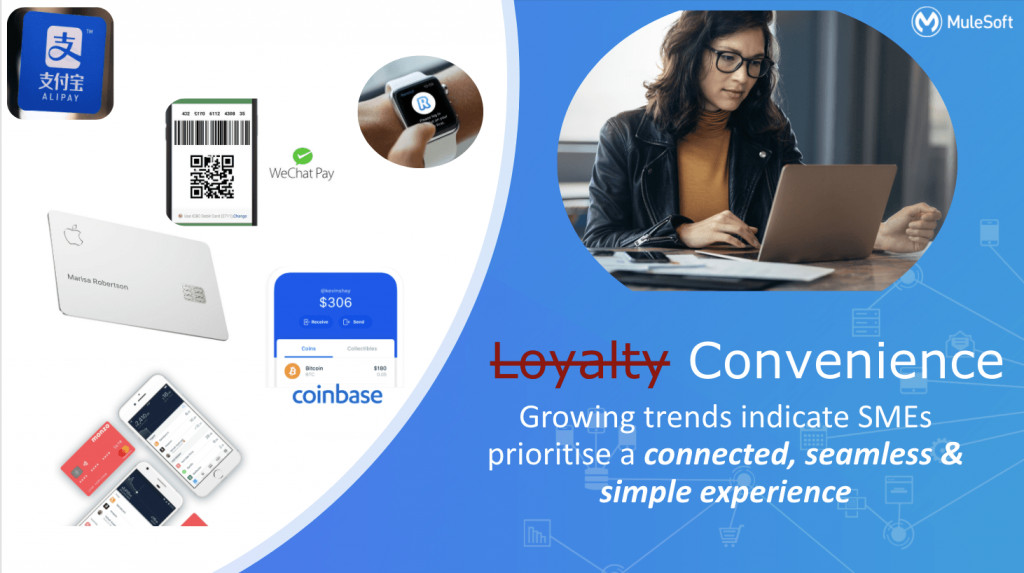As consumers, we all have experienced massive shifts in expectations — we are no longer loyal to brands, but rather to the best consumer experience. As a result, highstreet banks have rapidly pivoted to offer new experiences that rival the most convenient consumer experiences from the likes of Monzo, Starling Bank, and Atom Bank.
It’s not only retail customers with elevated expectations — there is an increasing demand from small to medium enterprises (SME), who deserve these connected experiences as well. This rise of simple and intuitive experiences has been coined the convenience economy.
The race among financial institutions to capture or defend this SME market share is well underway. As a result, MuleSoft has been working with a number of financial organizations to deliver a truly differentiated experience for the sought-after SME market segment.
What SME customers expect from their bank

We know that SME banking customers expect the same connected experience that they might be getting from their personal bank — or from those fintechs whose advertisements fill up most inner-city billboards and underground stations. An example of one such expectation is managing multiple SME banking products and services in a single app while receiving relevant offers, support or advice 24/7. Moreover, modern-day consumers are much more empowered to move providers when their expectations are not being met — in some cases, they are incentivized for doing so with cashback upon switching. This is a trend that has been actively encouraged by governments around the world, such as through UK CMA regulations: the Current Account Switch Service (CASS) and open banking.
Why is convenience so hard for banks to deliver
It sounds simple. There is demand and market share to be won, so it should be easy for SME banks to win over new business by catering to these new demands, right?
This is how it should be. SME banks need to rapidly react, adapt, and partner where necessary to create the experiences that their customers and prospects are screaming out for. Yet the reality for a number of financial organizations is that this is far from easy. In our experience, many banks offering SME services have found themselves held back from moving with the speed and agility they need to, with the following challenges often cited:
- Decades of siloed channel development and ownership.
- Complex mergers, acquisitions, and separations creating fragmented IT estates.
- Under-investment in central IT and digital transformation.
- Project-by-project mindsets (often caused by the factors above).
However, funding and technology alone are not the silver bullets for truly differentiating an organization’s digital offerings. Banks must also change the way they operate to ensure any improvements to the customer experience are more than short-term fixes.
MuleSoft enabled banks to continually and consistently deliver to their clients, through providing both market-leading connectivity paired with a shift in their way of working — an operating model facilitating agility and innovation. This operating model allows organizations to maximize their investment, through repurposing and reuse, naturally facilitating a business case that offers opportunities to remove operating cost through simplifying and rationalizing the IT landscape. The result is innovative, flexible, and connected banking experiences that last.
One such example is a large tier two UK bank, who became a joint MuleSoft-Salesforce customer to realize their strategy of driving a differentiated SME banking experience, ultimately to deliver a key strategic goal “to double market share of SME banking customers over the next five years.”
What changes are required to meet these needs?
According to Forbes, 69% of SME business owners cite cashflow worries as what keeps them awake at night. For these business owners to move towards financial peace of mind, they need support and guidance that the current banking offerings in the SME landscape aren’t providing. Let’s look at what changes are required from the bank’s perspective to support this:
The customer experience
SME banks must support a seamless journey through the devices and channels its customers are using to manage their financial lives. For most SME banks, here lies the first obstacle. In a typical SME banking scenario, it’s likely a bank would provide an online portal, a mobile app, telephone banking facilities, and in-branch kiosks. However, these experiences are often far from connected, with customers even getting different views of their money depending on which channel they interact with, and at which point in the day. This disconnected experience is usually compounded when a customer holds more than one account or product.
Financial insights
SME organizations need their money to work with them and for them. From the bank’s perspective, this requires providing relevant products and services that are offered or even automatically applied for SME banking customers to fully support their business needs. This also requires the bank to offer insightful analysis of spending trends, projections of cash flow, and even new services that support the accounting and invoicing sides of operations. Those who differentiate are those that offer these additional services within the context of the customer and their business. Banks need to offer the right combination of products and support, at the right time in that business owner’s journey, these suggested products can’t be generic, irrelevant or too late.
What’s next?
This first blog installment on the SME banking ecosystem highlights the market share battlefield that has been opened up through the growth of a convenience economy. We’ve discussed how financial organizations can capitalize on this rise in expectations from SME banking customers, by providing connected and digital experiences for their customers.
The focus of Part two of this blog installment is to dive into what changes are required to realize these connected experiences, and where MuleSoft has been helping other banks transform their customer experiences.
Learn how to modernize your customer engagement with APIs with an open-banking strategy.









